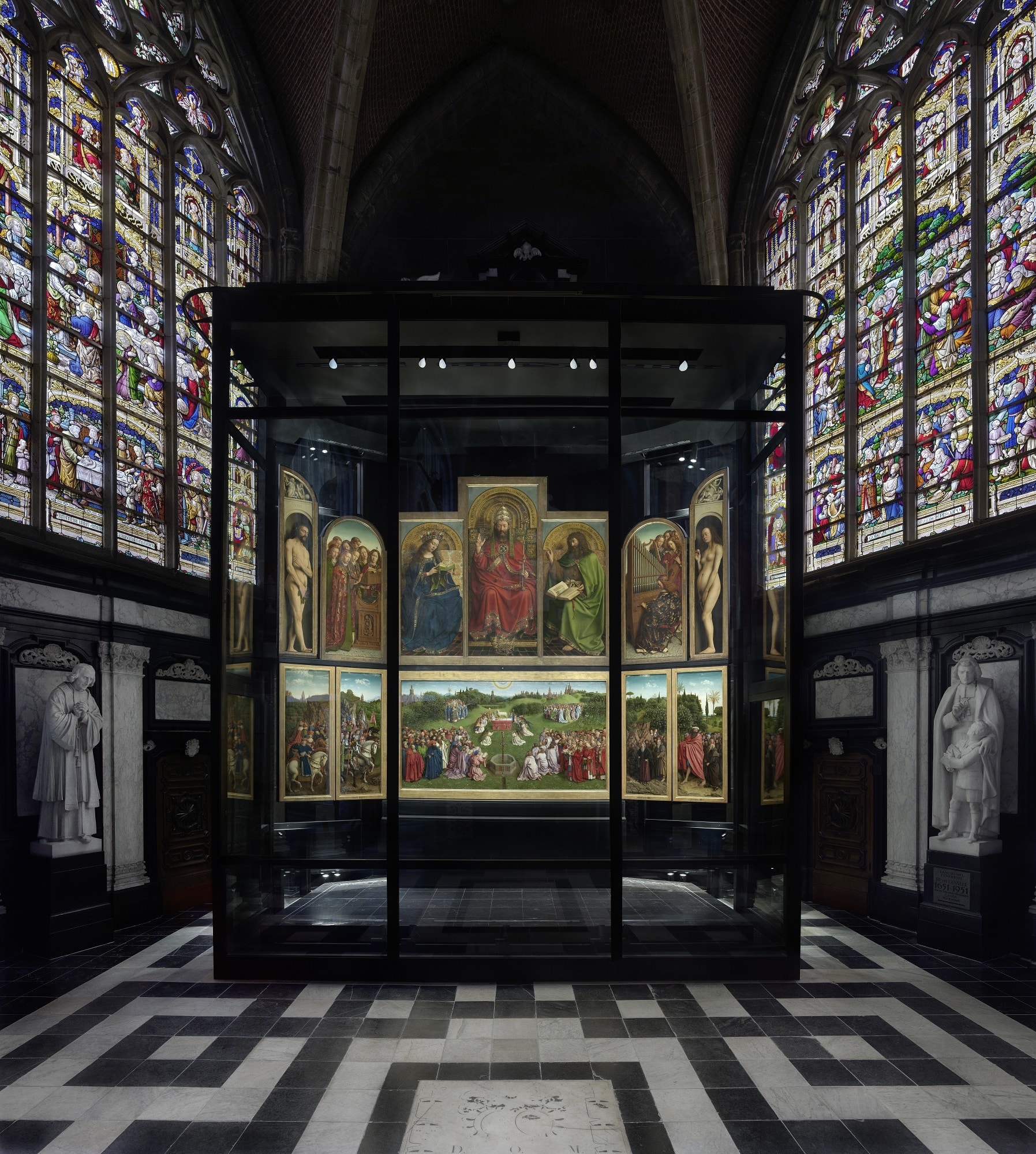As part of the restoration projects undertaken in Flanders, The Ghent Altarpiece by Jan and Hubert Van Eyck, has been moved to its new location at St. Bavo’s Cathedral in Ghent. At the same time the Cathedral also revealed a new visitor experience. The Cathedral crypt has been extensively adapted for visitors to experience the artwork’s history, via new visual technology.
The Ghent Altarpiece is widely recognized as one of history’s most influential works of art. It is made up of twelve panels, painted recto-verso, with the iconic panel, The Adoration of the Mystic Lamb, at its centerpiece. At the time of its completion in 1432, the van Eyck creation, intended for public viewing, provided color, brilliance, and vividness that astounded the peers of its time. Today, thanks to an extensive restoration project, the artwork can be admired by the public, in its original home, at a new setting in the Cathedral.
New setting at St. Bavo’s Cathedral
Over the centuries, the Ghent Altarpiece has been moved from several locations both within and outside the Cathedral. The masterpiece has also been subject to numerous historic restorations, but the most recent work carried out by the Royal Institute for Cultural Heritage (KIK-IRPA) provided a much-needed repair and restoration to the polyptych’s central image and lower register panels. These also formed part of the recently acclaimed “Van Eyck – An Optical Revolution” exhibition at the Fine Arts Museum Ghent (MSK) in 2020.
 The Ghent Altarpiece in its new glass case in the Sacrament Chapel of St. Bavo’s Cathedral, Ghent
The Ghent Altarpiece in its new glass case in the Sacrament Chapel of St. Bavo’s Cathedral, Ghent© Art in Flanders, photo by Cedric Verhelst
A glass case has been designed to house the polyptych and will re-create the optimum conditions for acclimatization, necessary for the preservation of this masterpiece.
In the 1980’s the masterpiece was moved for safety and conservation reasons from its original location, the Vijd Chapel in the ambulatory, to the Villa Chapel which was close to the Cathedral’s main entrance. The chapel was often overcrowded, especially when groups entered. To overcome this problem, the visitor experience needed to be re-thought.
The main aim was to separate the interpretation of the Ghent Altarpiece from its presentation. The Cathedral crypt provided the perfect venue for the interpretation aspect, but it also required a contiguous path to then view the Ghent Altarpiece. As such, a return to the Villa Chapel wasn’t a viable option. It turned out to be a difficult balancing act in harmonizing the religious function of the Cathedral, as a place reserved for service, with the cultural-touristic function.
Consideration had to be made to ensure there was enough space to accommodate the new glass case with an unhindered view of its interior and exterior panels. With space constraints in the Vijd Chapel, the move to the Sacrament Chapel was chosen for its proximity to its original home in the ambulatory, but also because its tranquil setting is more conducive to an intimate encounter with the painting, with a bigger surface area.
A new heritage experience
As part of the visitor experience, the Cathedral has undergone a restoration process to create an appropriate and suitable space to offer visitors a place to view the full context of this renowned artwork. The Cathedral Crypt has been preserved, renovated, and redesigned and will act as the starting point for the Ghent Altarpiece
visitor experience.
Using an innovative concept in the field of museology, St. Bavo’s Cathedral will launch a new era in its presentation of heritage in its ancient setting. Visitors will be given the aid of a personal virtual digital assistant to lead them from chapel to chapel, prior to viewing the main painting.
In each of these chapels, Augmented Reality (AR) glasses or an AR tablet will allow them to view a scene, enhanced with an additional layer of virtual experience, superimposed to create a life-like visual effect. The experience will be further enhanced with storytelling, transporting visitors back through time to the period when the Ghent Altarpiece was painted.
St. Bavo’s Cathedral becomes fully accessible
The architectural restoration for this project was undertaken by Bressers Architects, a local Ghent-based firm. To realize the need for modern-day optimal full accessibility, in an ancient building like the Cathedral, required the expert intervention of innovative and forward-thinking planning. Not only was full accessibility required for both the crypt and the choir but also the apsidal chapels, including the Sacrament chapel. This required the addition of a new elevator and stairs but also demolition and redesign of some of the Cathedral’s ancient stone walls.
Sympathetic integration with the look of the existing building was undertaken to enable the accessibility of a much larger part of the Cathedral, previously only available to the lower part of the church. To make the extensive restoration works possible, a sum of €30 million euros was raised with the support of the Flemish Government and other sponsors. This included the restoration work in the crypt and coronary chapels, the erection of the new circulation volume, the new display case for the Ghent Altarpiece and its climatization, together with the installation of its new high-tech visitor experience.
Due to the pandemic, the Van Eyck Year has been extended until Spring 2021. For further information about the new visitor center at St. Bavo’s Cathedral, visit www.sintbaafskathedraal.be or www.vaneyckwashere.be.












